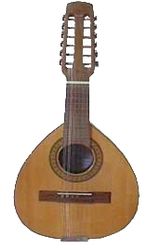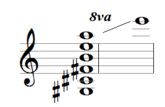Thebandurriais apluckedchordophonefromSpain,similar to themandolinandbandola,primarily used inSpanish folk music,but also found in former Spanish colonies.
 | |
| String instrument | |
|---|---|
| Classification | Pluckedchordophone |
| Hornbostel–Sachs classification | 321.321and321.322 (Necked bowl lute for roundback, necked box lute for flatback) |
| Playing range | |
 | |
| Related instruments | |
| Bandola,laúd,mandolin,octavina | |
Instrument development
editPrior to the 18th century, the bandurria had a round back, similar or related to themandore.[1]It had become a flat-backed instrument by the 18th century, with five double courses of strings, tuned in fourths.[1]The original bandurrias of theMedievalperiod had three strings. During theRenaissancethey gained a fourth string. During theBaroqueperiod the bandurria had 10 strings (5 pairs).
The modern bandurria has 12 strings (6 pairs). The strings are tuned in unison pairs, going up in fourths from the low G#. The lowest four strings are a major-third above those of a standard guitar and the highest two strings are a fourth above a standard guitar, i.e. G♯,c♯,f♯,b, e and a.[2]
-
Bandurria (front view)
-
Bandurria (back view)
-
Bandurria (tailpiece)
-
Bandurria (tuning head)
Variations and uses in different parts of the world
editSpain
editJuan Ruiz first mentioned the term "mandurria" in the 14th century in his "Libro De Buen Amor."[6]After that, Juan Bermudo gave the description of the bandurria in his "Comiença el libro llamado declaraciõ de instrumentos"as a three-string instrument in 1555, but he also mentioned other types with four or even five strings. In the early 1870s, a child's wake was accompanied with the bandurria music in Jijona, Alicante Province. Thezapateo,a dance derived from the Spanish zapateado and introduced by tobacco cultivators from the Canary Islands, is accompanied with bandurria and other instruments before 1900.
Philippines
editThe Philippine harp bandurria is a 14-string bandurria used in many Philippine folkloric songs, with 16 frets and a shorter neck than the 12-string bandurria.[2]This instrument most likely evolved in thePhilippinesduring theSpanish period,from 1521 to 1898. The Filipino bandurria (alsobanduriya[7]) is used in an orchestra of plucked string instruments calledrondalla.It is tuned a step lower than the Spanish version, that is, low to high: F# B E A D G.[8]Filipino bandurrias have been made with coconuts,[9]and asbanjoleleswith banjo bodies and goatskin soundboards.
South America
editThere are also many different varieties of bandurria in South America, especially Peru and Bolivia. They have four courses, unlike the traditional Spanish six courses.[2]The four courses are double, triple or quadruple, and the tuning is guitar-like, rather than the fourths tuning used on the Spanish type.[10]In Lima, Peru, harp and bandurria duos were common in the early 20th century. Nowadays people there still play bandurria accompanying with the popular vals peruano, or vals criollo.[6]
United Kingdom
editAlthough generally little known in the UK, the bandurria was used by Roy Williamson of the Scottish folk-group The Corrie Folk Trio. When this group later (after the loss of one member) becameThe Corries,Williamson incorporated a bandurria into one of the two multi-instrument "combolins" that he constructed for himself and his partner.
Notable players and music
edit- Javier Mas "Tamiz".[11]
- Rick Walker, a British musician, played this instrument on the song 'A Twilight Zone' by the artist Aim.
See also
editReferences
edit- ^abTyler, James; Sparks, Paul (1992).The Early Mandolin.Oxford: Clarendon Press. p.52.ISBN0-19-816302-9.
- ^abc"B".Stringed Instrument Database.14 September 2013.
- ^"Death of Henry E. Abbey; The Well-Known Manager's Long Career Closed. The New York Times. October 18, 1896. Column 3"(PDF).
- ^Sparks 2003,p. 23–29
- ^Music and Society in 19th-Century Nueva Granada and Colombia.The bandola and its History Through Iconographic Sources (1850–1900)by Egberto Bermúdez, pages 158, 160, 161
- ^ab Schecter, John (2007). "Bandurria".Grove Music Online(Oxford Music Online ed.). Oxford University Press.doi:10.1093/gmo/9781561592630.article.01951.
- ^"Banduriya".philippinelanguages.
[language] Hiligaynon
- ^"The Stringed Instrument Database: Index".stringedinstrumentdatabase.aornis.Retrieved22 February2019.
- ^"Banduria late 19th–early 20th century Philippine".Metropolitan Museum of Art.
- ^"South America".ATLAS of Plucked Instruments.Retrieved22 February2014.
- ^Mas and Rallo (Jun 15, 2000).Tamiz(MP3). 2000 Harmonia Mundi.ASINB0018BUBNQ.
Bibliography
edit- Sparks, Paul (2003).The Classical Mandolin.Oxford: Oxford University Press.ISBN9780195173376.